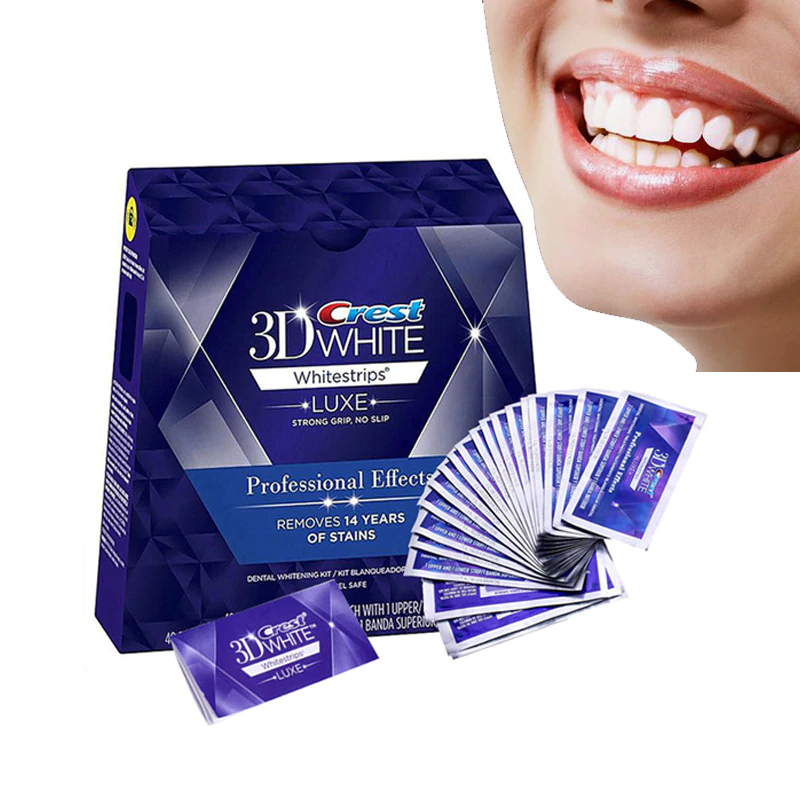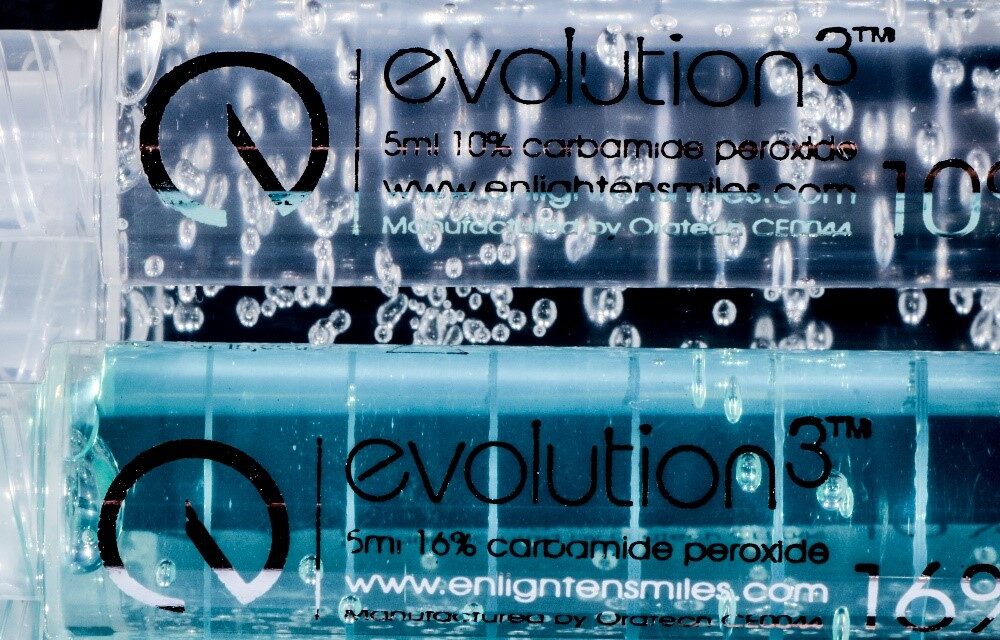There are many different types of whitening systems that are available to patients/consumers, which can be divided into professional systems and non-professional systems.
Whitening Systems Over-the-Counter
These whitening systems are often bought online, or in many mainstream high street shops. However, due to them not being on prescription, the concentration of hydrogen peroxide is a lot less than systems provided by dentists. Due to this, the cost is also a lot less and results are less effective!
- Whitening toothpaste
These do mildly whiten the teeth but contains abrasive ingredients that remove stains on teeth after professional clean (oral hygiene visit). Used for a long period of time can create sensitivity as they are abrasive and wear off tooth enamel.

- Charcoal toothpaste
Historically used before fluoridated toothpastes and known for its black and abrasive properties. It has seen a resurgence due to health fads promoting its use, but it does not have the teeth protective elements of fluoridated toothpaste.

- Whitening strips – Crest 3D
Thin clear strips that you apply over the teeth once a day with hydrogen peroxide concentrations up to 35%.

- Power Whitening
Brands such as Hey Smile contain trace elements of hydrogen peroxide or none at all! Some contain other chemical agents that are damaging to teeth. The power element is referring to the LED light that is shined against the teeth to accelerate the process. The idea is the light and heat agitate the chemical to make it work faster.

Emerging methods:
- PAP-Phthalimidoperoxycaproic acid
An up-and-coming new chemical that is difficult to pronounce but has seen a surge in popularity in recent years. It is an oxidising agent, similar to bleach and does not require a dentist’s input. The initial results are promising, but the research data does not exist in enough volume to validate it’s safety long-term, which is why dentists are not advocating it’s use, yet.
Professional Whitening Systems
These whitening systems are performed by dentists with a higher concentration of Hydrogen peroxide and with custom made whitening trays. For this reason they are more expensive than other whitening methods. We can divide professional whitening systems into 2 categories: in chair or in office or in clinic teeth whitening (also known as in practice teeth or power whitening) and at home teeth whitening (also known as day/night whitening).
- In chair
The teeth are dried and set against the whitening gel for up to 2 hours. Usually 6% hydrogen peroxide is used and the results are short lived due to peroxide being more effective over a longer period of time. Dehydration over the 2 hours period creates a false whitening effect and this is why we see great initial results after in chair whitening, for it only to relapse to the original colour shortly after. To maintain the colour, you will need to whiten them at home too.

- Home whitening
Teeth whitening that patients can perform at home during the day or overnight, depends on what it is easier for them. Impressions or moulds of teeth are taken, and trays are made by dentist or dental technician. The dentist will provide you with enough whitening gel syringes and will explain how to load the trays to wear at home. At home teeth whitening kits can be divided into day and night. Day white is 6% Hydrogen Peroxide, you apply the gel in the whitening trays and keep them in for 3-6 hours for a period of 2-4 weeks. Night white can be 10% Carbamide Peroxide and 16% Carbamide Peroxide, same process as day whitening but you wear the whitening trays overnight. Is recommended to start with the 10% for the first week and move to the 16% the second week. We can also find different brands such as Enlighten, Zoom, White Beauty, Opalescence, Boutique, Polar.


Conclusion – which approach is right for you?
1st Choice is our Gold standard technique – Home Whitening 2-4 weeks using Enlighten or Zoom, with custom trays
2nd choice is Daytime whitening 1 hour per day for 2-3 weeks, custom trays
3rd choice is Strips, but only in the USA to remain legal!
4th choice are Alternatives – PAP, and other non-standard reductive and oxidising agents, many still not fully tested under peer reviewed research, but they might be promising as a low-cost alternative in the future. Seek advice from a cosmetic dentist near London prior to proceeding. Our team at Marylebone Smile Clinic are hugely experienced in whitening techniques.

FAQs
Which brand of whitening gel is best?
In our opinion Enlighten and Zoom are the best whitening gels in the UK. Enlighten needs to be kept refrigerated and Zoom does not require refrigeration due to two-barrel application. Peroxide breaks down over time to exposure to heat and light, which is why enlighten is in a refrigerated supply chain consisting of cold packs and Zoom is stored in two-barrel syringes.
Is it better to get teeth whitening by a dentist?
Yes, the professional whitening systems are more effective, and safer long-term.
Can I do my own teeth whitening professionally at home?
Yes, you can by using the home whitening system advised by a cosmetic dentist
How long does teeth whitening last?
If you use a gold standard technique, It will last indefinitely as long as you top-up one night/day every 2-3 months.
Do LED lights whiten teeth?
The LED light itself does not whiten teeth, but the light accelerates the action of the gel it is shining on. This allows in surgery power whitening to be carried out rapidly. In our experience, whilst it does create a whitening effect, it is short lived due to the extremely short exposure time against the teeth.
Does whitening hurt?
No, however, sensitivity is the most common sensation during the process. It can range from very mild to extreme sensitivity. This is only temporary and subsides after you stop whitening. There is no long-term damage being caused here, as it is simply a side effect of the teeth becoming more porous due to effect peroxide has on enamel.
How do I reduce teeth sensitivity?
If your teeth are sensitive during the whitening process, you can wear the trays every other day, use a sensitive toothpaste within the trays. Tooth Mousse, or CPP-ACP based gels used within the trays are an excellent approach to sensitivity.
Can I have tooth whitening if my teeth are unhealthy?
It is always recommended to have a dental health check before start whitening your teeth. There are some conditions that can be made worse by whitening, but on the whole, whitening is generally safe for most people. Your dental health must come as a priority before cosmetic dental procedures.
Can I whiten my teeth if I have no enamel, or worn down my teeth?
If you have no enamel at all, whitening would be of very little benefit, as the enamel is what gives teeth their very white appearance. The good news is that is is quite rare to have NO enamel remaining. Throughout our lives, the enamel shell thins as we age and use our teeth, the thinnest layer of enamel can still be whitened without causing damage, and this can be the case with worn teeth. So, if you grin your teeth at night and/or suffer from erosion, speak to a cosmetic dentist before undergoing whitening.
Want to know more?
Get in touch to enquire about our services or to book an appointment.



